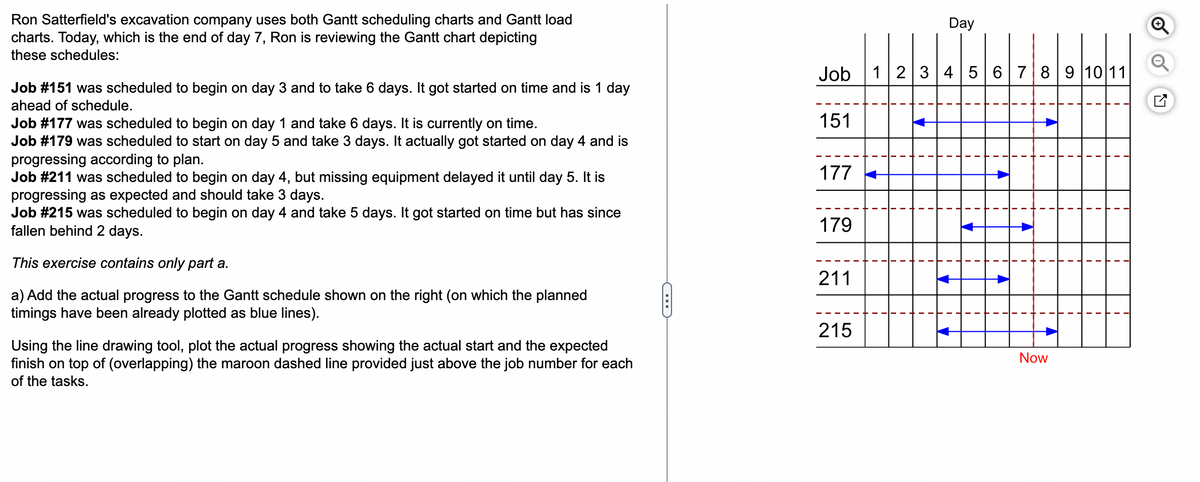Ron Satterfield's excavation company uses both Gantt scheduling charts and Gantt load charts. Today, which is the end of day 7, Ron is reviewing the Gantt chart depicting these schedules: Job # 151 was scheduled to begin on day 3 and to take 6 days. It got started on time and is 1 day ahead of schedule. Job # 177 was scheduled to begin on day 1 and take 6 days. It is currently on time. Job #179 was scheduled to start on day 5 and take 3 days. It actually got started on day 4 and is progressing according to plan. Job # 211 was scheduled to begin on day 4, but missing equipment delayed it until day 5. It is progressing as expected and should take 3 days. Job # 215 was scheduled to begin on day 4 and take 5 days. It got started on time but has since fallen behind 2 days. This exercise contains only part a. a) Add the actual progress to the Gantt schedule shown on the right (on which the planned timings have been already plotted as blue lines). Using the line drawing tool, plot the actual progress showing the actual start and the expected finish on top of (overlapping) the maroon dashed line provided just above the job number for each of the tasks. Job 151 177+ 179 211 215 Day 1 2 3 4 5 6 7 8 9 10 11 Now
Ron Satterfield's excavation company uses both Gantt scheduling charts and Gantt load charts. Today, which is the end of day 7, Ron is reviewing the Gantt chart depicting these schedules: Job # 151 was scheduled to begin on day 3 and to take 6 days. It got started on time and is 1 day ahead of schedule. Job # 177 was scheduled to begin on day 1 and take 6 days. It is currently on time. Job #179 was scheduled to start on day 5 and take 3 days. It actually got started on day 4 and is progressing according to plan. Job # 211 was scheduled to begin on day 4, but missing equipment delayed it until day 5. It is progressing as expected and should take 3 days. Job # 215 was scheduled to begin on day 4 and take 5 days. It got started on time but has since fallen behind 2 days. This exercise contains only part a. a) Add the actual progress to the Gantt schedule shown on the right (on which the planned timings have been already plotted as blue lines). Using the line drawing tool, plot the actual progress showing the actual start and the expected finish on top of (overlapping) the maroon dashed line provided just above the job number for each of the tasks. Job 151 177+ 179 211 215 Day 1 2 3 4 5 6 7 8 9 10 11 Now
Managerial Economics: A Problem Solving Approach
5th Edition
ISBN:9781337106665
Author:Luke M. Froeb, Brian T. McCann, Michael R. Ward, Mike Shor
Publisher:Luke M. Froeb, Brian T. McCann, Michael R. Ward, Mike Shor
Chapter4: Extent (how Much) Decisions
Section: Chapter Questions
Problem 3MC
Related questions
Question
100%

Transcribed Image Text:Ron Satterfield's excavation company uses both Gantt scheduling charts and Gantt load
charts. Today, which is the end of day 7, Ron is reviewing the Gantt chart depicting
these schedules:
Job #151 was scheduled to begin on day 3 and to take 6 days. It got started on time and is 1 day
ahead of schedule.
Job #177 was scheduled to begin on day 1 and take 6 days. It is currently on time.
Job #179 was scheduled to start on day 5 and take 3 days. It actually got started on day 4 and is
progressing according to plan.
Job # 211 was scheduled to begin on day 4, but missing equipment delayed it until day 5. It is
progressing as expected and should take 3 days.
Job #215 was scheduled to begin on day 4 and take 5 days. It got started on time but has since
fallen behind 2 days.
This exercise contains only part a.
a) Add the actual progress to the Gantt schedule shown on the right (on which the planned
timings have been already plotted as blue lines).
Using the line drawing tool, plot the actual progress showing the actual start and the expected
finish on top of (overlapping) the maroon dashed line provided just above the job number for each
of the tasks.
Job 1 2 3 4 5 6 7 8 9 10 11
151
177
179
211
Day
215
4
A
A
Now
i
i
O
Expert Solution
This question has been solved!
Explore an expertly crafted, step-by-step solution for a thorough understanding of key concepts.
Step by step
Solved in 3 steps with 1 images

Knowledge Booster
Learn more about
Need a deep-dive on the concept behind this application? Look no further. Learn more about this topic, economics and related others by exploring similar questions and additional content below.Recommended textbooks for you

Managerial Economics: A Problem Solving Approach
Economics
ISBN:
9781337106665
Author:
Luke M. Froeb, Brian T. McCann, Michael R. Ward, Mike Shor
Publisher:
Cengage Learning

Managerial Economics: Applications, Strategies an…
Economics
ISBN:
9781305506381
Author:
James R. McGuigan, R. Charles Moyer, Frederick H.deB. Harris
Publisher:
Cengage Learning


Managerial Economics: A Problem Solving Approach
Economics
ISBN:
9781337106665
Author:
Luke M. Froeb, Brian T. McCann, Michael R. Ward, Mike Shor
Publisher:
Cengage Learning

Managerial Economics: Applications, Strategies an…
Economics
ISBN:
9781305506381
Author:
James R. McGuigan, R. Charles Moyer, Frederick H.deB. Harris
Publisher:
Cengage Learning



Essentials of Economics (MindTap Course List)
Economics
ISBN:
9781337091992
Author:
N. Gregory Mankiw
Publisher:
Cengage Learning

Microeconomics: Principles & Policy
Economics
ISBN:
9781337794992
Author:
William J. Baumol, Alan S. Blinder, John L. Solow
Publisher:
Cengage Learning